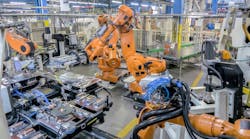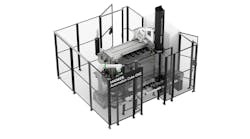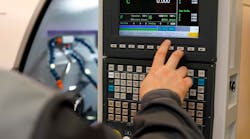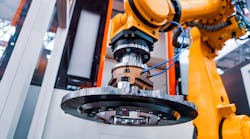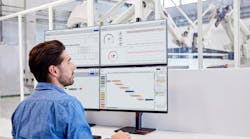The toughest challenge computer numeric control manufacturers face is to control external devices through machine tool CNCs.
Shops typically add external devices and, often, the easiest method to control those devices — for the shop — is through the machine tool CNC. It’s available and it’s already on the shop floor.
Manufacturers look for a variety of ways to put additional equipment under CNC control.
Siemens Energy & Automation Inc. (http://usa.siemens.com/cnc) accomplishes it by equipping its controls with multiple channels and by rewriting data for programmable logic controls to make the interface connection to any device a shop wishes to control.
Siemens’ 840 D control, for example, has as many as ten channels. In effect, that makes the CNC 10 separate controls, and allows shops to control 10 external devices with one piece of hardware.
Siemens said the 840 D can run 10 separate programs simultaneously.
Control channels eliminate the need to have separate controls for each external device and eliminates the need to have them communicate through N codes or other commands. So a shop can run 10 three-axis machines in an automated cell with an 840 D control.
Randy Pearson, manager of dealer and end user support at Siemens, said PC-based controls also help overcome the challenges of automation. Those controls can run any thirdparty Windows software applications to allow machine tool OEMs to map keys that allow users to access the loaded software packages within the control.
Such packages can include tool management, networking and data acquisition. In addition, networking within PC-based controls allows the controls to communicate with other machine tools, such as in an automated cell.
Pearson said he sees Ethernet-based feedback moving in the direction for shops to be able to plug in an external device, and have the control recognize it and set parameters for it. This technology works through electronic data/nameplates that are built into motors. The system reads the electronic data to complete the setup.
Controlling plant-wide automation
At BMW’s Spartanburg, S.C., plant, Siemens implemented seven solutions in the company’s final assembly operations, including joining chassis to engines, several different conveyor systems and a plant-wide automation system. The project converted a two-line assembly system into a oneline system enhanced with the latest manufacturing technologies. The conversion gives BMW flexibility to vary production for its models. It can change from producing all X5 SUVs to a mix of 40 percent X5 SUVs and 60 percent Roadster Z4s.
As part of the project, BMW and Siemens modernized several conveyor systems and, altogether, six kilometers of new conveyors were installed. Those included a new skid system with 81 skids, a 300-m skid system was converted, and a 150-m chain conveyor and a heavy load conveyor with 91 suspension tackles, were installed.
Siemens Simatic controllers control all of these systems, including the EMS drivers.
In addition, the factory’s new automation system complies with the international standard established at BMW’s Munich, Germany, factory. Meeting that company standard required a substantial amount of hardware and software at the Spartanburg facility.
Siemens installed 20 Simatic S7-400-type PLCs and seven S7-400F controllers, all of which form the nucleus of the new automation system. Approximately 200 IM 151-F-CPU modules, 2,000 drives, 45,000 I/O devices and 240 switch cabinets were installed to communicate, via more than 400,000 meters of cable, to allow all the systems to interact smoothly. Seventy-five MP370 operator panels and 121 Simatic OP77B panels provide the human machine interface (HMI).

